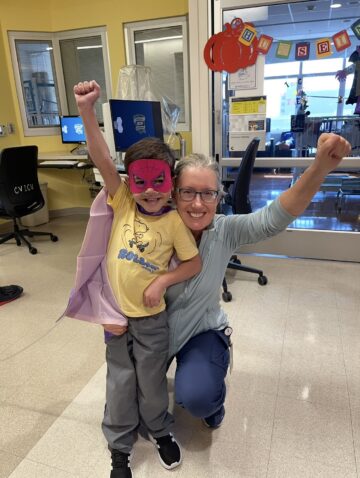Even through intense water polo training and games, Ashley Klein had never experienced as much as a flutter inside her chest. And suddenly, emergency department staff were using words like heart failure, bypass, transplant and pacemaker.
A routine sports physical showed Ashley had an elevated heart rate, and CHOC cardiologist Dr. Anthony McCanta ultimately diagnosed her with ventricular tachycardia, a condition wherein her heart beat too fast and pumped blood in a dyssynchronous, or disorganized, way. This caused her heart muscle to weaken and enlarge, a second diagnosis called tachycardia-induced cardiomyopathy.
Though she felt perfectly fine, unbeknownst to Ashley, she’d had a ticking time bomb inside her chest.

“When you read about those poor kids who die suddenly at sports practice, this is that,” Ashley’s mother, Lisa, said. “It was really frightening.”
Ashley’s heart was only pumping out about 13 percent of the blood in its left ventricle. This measurement is called ejection fraction, and a normal heart should pump at least 55 percent. Ashley was at great risk for heart failure, and Dr. McCanta needed to work quickly.
After trying anti-arrhythmic medications, Dr. McCanta opted to correct the problem through radiofrequency ablation. By inserting catheters through Ashley’s leg and up into the heart, he would destroy cells in Ashley’s heart that were misfiring and causing the problem.
But in Ashley’s case, this procedure was especially complicated because of the location of the problem inside her heart.
Dr. McCanta and his team used catheters to create detailed 3-D maps of the inside of Ashley’s heart. The maps revealed the abnormality that was causing the rapid heartbeat was in the ventricle, but near the atrioventricular (AV) node, which sends electrical signals between the upper and lower portions of the heart.
Harming the AV node during the ablation would have resulted in Ashley needing a pacemaker. However, not correcting the ventricular tachycardia would almost certainly increase her risk of severe heart failure and lead to the possibility of needing a heart transplant, Dr. McCanta said.
“This was a risky procedure with very high stakes. Precision was even more important than it usually is,” he said. “During the procedure, I discussed the risks of potential AV node injury versus worsening heart failure with Ashley’s family, and they decided it was more important to take care of it. So, we fixed the problem in a safe way.”
To ensure total accuracy, Dr. McCanta relied on the detailed 3-D heart mapping and a precise radiofrequency burn to ablate the problematic cells. The technology is used in CHOC’s state-of-the-art cardiac catheterization lab.
Within days of her procedure, Ashley’s heart function was almost completely restored and her ejection fraction had increased to about 48 percent.
“Her recovery has been remarkable,” Dr. McCanta said.
After taking the summer off from sports to recover, Ashley, 16, re-joined her water polo team this past fall.
“We are so grateful Ashley was at CHOC,” Lisa said. “Throughout the whole ordeal, we had complete faith in her doctor and knew that, regardless of the outcome, she was being given the best care by the best doctors and nurses. We would not have wanted to be anywhere else.”
Lisa added, “We want to stress the importance of sports physical, which we used to consider tedious. It literally saved our daughter’s life.”
Learn more about CHOC’s electrophysiology program.





